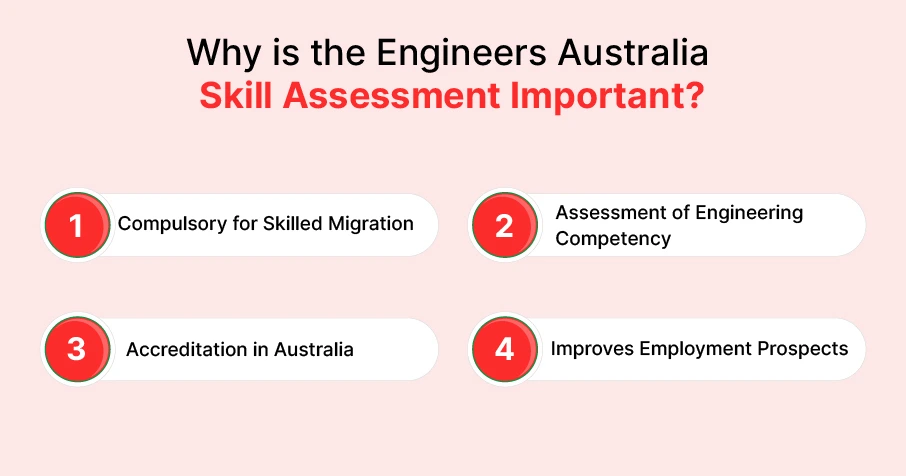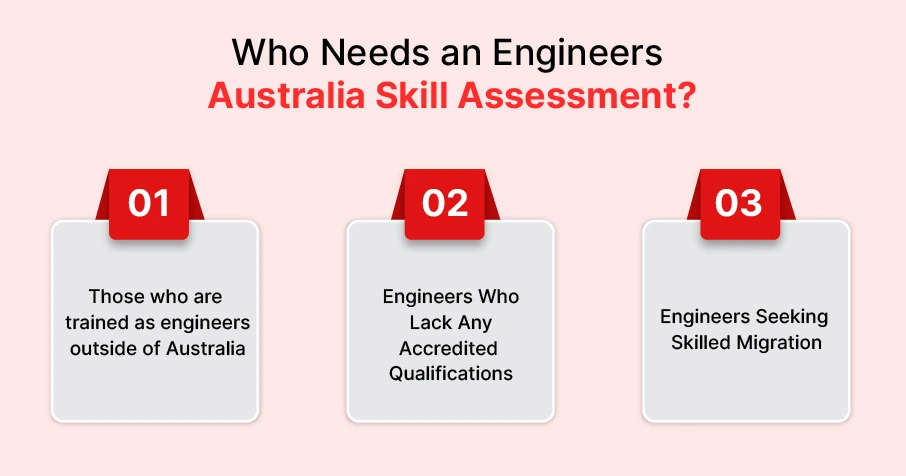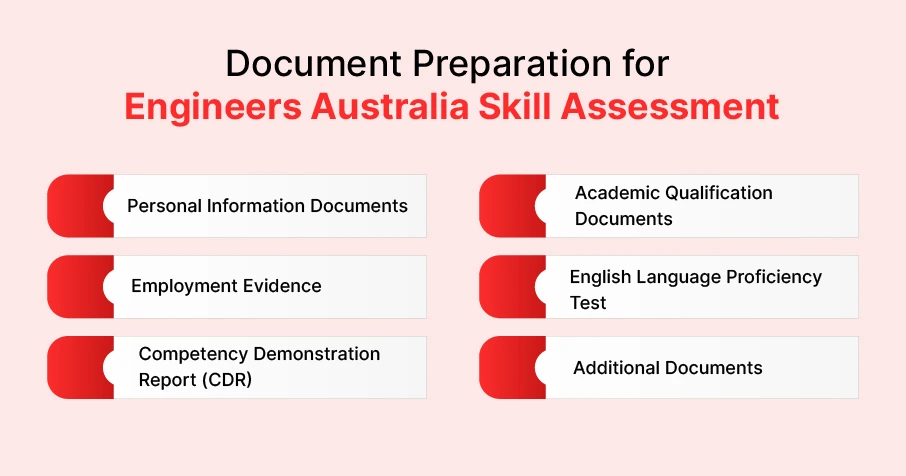The first step if you want an engineer to migrate to Australia is obtaining a positive skills assessment by Engineers Australia (EA). This assessment certifies that a person’s qualifications and working experience meet certain Australian standards. EA is the approved assessing authority for engineering occupations under the General Skilled Migration Programme.
In this guide, we have explained the details of the Engineers Australia Skill Assessment overview of eligibility requirements, assessment pathways, document preparation, submission process, common pitfalls, and ways to avoid them.
What is Engineers Australia’s skill assessment?
The process of Engineers Australia Skill Assessment is deemed very crucial as it evaluates the qualifications and work experience of an engineer to determine if the engineer has reached Australian standards of engineering.
Engineers Australia, the professional body mandated to assess engineering occupations under the General Skilled Migration programme, carries this out. For are an internationally qualified engineer wishing to migrate across the Dubly under the skilled visa category, you must go through this skill assessment process.
A favourable outcome from Masters Australia means that your qualifications and experience meet Australian standards and within this context, you will be entitled to apply for visas such as:
Skilled Independent Visa (subclass 189)
Skilled Nominated Visa (subclass 190)
Skilled Work Regional Visa (subclass 491)
This helps ensure that only competent and qualified engineers get into the Australian workforce, thereby maintaining high industry standards.
Why is the Engineers Australia Skill Assessment Important?

There are different important reasons to conduct such an assessment:
1. Compulsory for Skilled Migration
Engineers aspiring to migrate to Australia under call lists are expected by the Australian government to secure positive skilled assessments.
2. Assessment of Engineering Competency
Engineers Australia assesses your qualifications, experience, and proficiency levels and ensures they meet the standards of engineering in Australia.
3. Accreditation in Australia
A good assessment may also lead to membership in Engineers Australia, with access to professional development and opportunities for networking forward in the future.
4. Improves Employment Prospects
Accreditation by Engineers Australia is accepted by many Australian employers, which becomes a focus for engineers getting jobs.
Who Needs an Engineers Australia Skill Assessment?

The skills assessment from Engineers Australia is required for:
1. Those who are trained as engineers outside of Australia
Engineers with qualifications obtained from outside Australia will be assessed suitably to verify that their degree is equivalent to Australian engineering qualifications.
2. Engineers Who Lack Any Accredited Qualifications
As an engineer, should your degree be unrecognised under the international agreements known as the Washington Accord, the Sydney Accord, or the Dublin Accord, then a Competency Demonstration Report (CDR) must be submitted for assessment.
3. Engineers Seeking Skilled Migration
Any engineer wishing to apply for an Australian skilled visa will be required to complete this assessment under the Skilled Migration programme.
Understanding the Engineers Australia Skill Assessment Pathways

The four main competency assessment pathways adopted by Engineers Australia depend on the applicant’s educational background and skills. Each pathway targets specific groups of engineers to ensure that only those who are eligible as per Australian standards for engineering are granted recognition.
1. The Accredited Qualifications Pathway
The Accredited Qualifications Pathway applies to engineers qualified through universities which already been recognised by Engineers Australia through formal agreements regarding accreditation. If you fall under this category, your assessment will thus be faster and simpler.
Who is eligible?
You qualify under this pathway if your degree is accredited under:
a. Accredited Australian qualifications
Foreign, but accredited by particular rules, Australian Qualification by Engineers Australia should normally be directly assessed under this pathway.
Australian engineering degrees fit AFQ.
b. Washington Accord
The Washington Accord is a mutual international agreement on engineering accreditation among several member countries. If your degree is from one of the Washington Accord’s signatory countries and the country became a signatory before your degree completion, it is automatically recognised by Engineers Australia.
c. Sydney & Dublin Accords
Sydney Accord applies to engineering technologists (three-year diploma holders) and engineering associates.
2. Competency Demonstration Report (CDR) Pathway
In case you have not attained a Washington, Sydney, or Dublin-accredited degree, you should submit a competency demonstration report that substantiates your knowledge in engineering.
Eligibility
- Engineers with qualifications from non-accredited institutions.
- Engineers who studied in countries not covered by international agreements.
- Other applicants are those who cannot show equivalence of their scores according to accredited standards.
What is a Competency Demonstration Report (CDR)?
A CDR is a report in which the applicant outlines his or her engineering proficiency, problem-solving capabilities, and level of professional experience through text.
What are the requirements for the CDR?
a. Curriculum vitae (CV)
A comprehensive resume detailing your academic qualifications and engineering work experience.
b. The Continuing Professional Development (CPD) Statement
This statement includes the engineering courses, training, and seminars attended to keep your knowledge fresh.
c. Three Career Episodes
A description of real-world engineering projects you have worked on, with each episode emphasising your role in the tasks, technical skills, problem-solving management, engineering knowledge, and any practical application thereof.
d. Summary Statement
A cross-reference summary table from Career Episodes mapping to the competency elements evaluated by Engineers Australia.
3. Mutual Recognition Agreement (MRA) Pathway
The Mutual Recognition Agreement (MRA) Pathway enables engineers from some professional engineering bodies to gain recognition from Engineers Australia without needing any further competency assessment.
Who is eligible?
In this pathway, you qualify if you are a registered engineer from a professional body that has an MRA with Engineers Australia.
Documents Required for MRA Pathway
Proof of membership in the recognised body.
Degree certificates and transcripts.
Any other suitable English language proficiency test results.
4. Australian Qualification Pathway
It applies to engineers who have studied in Australia and achieved accreditation through qualifications recognised by Engineers Australia.
Who is eligible?
Engineers who completed a university degree in engineering in Australia.
Documents
An attested copy of the degree certificates.
Academic transcripts.
English proficiency test results.
Document Preparation for Engineers Australia Skill Assessment

For the Engineers Australia (EA) Skill Assessment to be successful, well-organised documentation has to be procured, which would justify your identity, qualifications, and work experience. Appropriate and organised documents will result in an undisturbed assessment process and a better chance of receiving a favourable decision.
1. Personal Information Documents
These are the documents used to establish your name and personal details.
A clear scanned copy of your passport bio page.
A photo page of your passport is proof of your identity and must be valid at the time of application.
A passport-sized photograph is of recent origin and follows the requirement of the issuing authority.
In case your name is not corresponding with the university or employment records, official name change certificates must also be attached (e.g., marriage certificate, affidavit, legal documentation of name change).
2. Academic Qualification Documents
EA checks whether your educational qualification meets the requirements of Australian engineering qualification changes.
a. A degree certificate
A photocopy of the engineering degree certificate is certified.
If you have more than one of these degrees (Bachelor’s, Master’s, and Ph.D.), attach all relevant certificates.
b. Academic Transcripts
Official transcripts detailing the subjects studied, grades awarded on each, and the date of completion.
If the applicants are unsure about their transcript certificates’ relevance, they should have their documents properly translated and get a notarized copy of the English version made.
3. Employment Evidence
To demonstrate your engineering work experience, submit the following:
a. Work Experience Certificates
Official experience letters from previous and current employers.
Should include:
- Company name and official letterhead.
- Employment start and end dates.
- Job title and position.
- A detailed description of engineering roles and responsibilities.
- Employer’s signature and contact details.
b. Employer Reference Letters
A formal reference letter from your supervisor or manager.
Should confirm your engineering responsibilities and technical contributions.
c. Salary Slips or Tax Records
Payslips, bank statements, or tax documents to verify employment history.
Engineers Australia may request additional proof of employment to ensure credibility.
4. English Language Proficiency Test
All applicants (except those from English-speaking countries) must provide proof of English proficiency.
Accepted English tests:
IELTS
TOEFL iBT
PTE Academic
5. Competency Demonstration Report (CDR)
If your engineering qualification is not accredited (i.e., does not fall under the Washington, Sydney, or Dublin Accords), you must submit a Competency Demonstration Report (CDR).
CDR Includes:
a. Curriculum Vitae (CV)
A well-structured resume of your academic and professional background.
b. Continuing Professional Development (CPD) Statement
A list of training programmes, workshops, and engineering courses attended.
c. Three career episodes
Detailed reports describing real engineering projects you worked on.
d. Summary Statement
A table mapping your career episodes to Engineers Australia’s competency elements.
6. Additional Documents
a. Migration Skills Assessment (MSA) Application Form
This is the official application form you submit to Engineers Australia.
It includes your personal information, qualifications, and work experience details.
b. Proof of Membership
If applying through the MSA Pathway, provide proof of membership in an EA-recognised professional body (e.g., Engineers Canada, Engineering Council UK).
c. Statutory Declaration
If you are self-employed, submit a detailed statutory declaration outlining:
Your engineering projects.
Client details.
Work contracts or invoices.
Conclusion
Engineering professionals who want a successful Engineers Australia Skill Assessment must prepare their documents carefully. Every applicant using the Accredited Qualifications Pathway, CDR Pathway, MSA Pathway, or Australian Qualifications Pathway must submit complete documents that prove authenticity.
Your Australian skilled migration journey will progress when you follow EA’s guidelines to prepare documents that have no errors, have a proper structure, and are properly certified.
Choosing the right Engineers Australia Skill Assessment Pathway is crucial to ensuring a smooth migration process.
FAQs
1. How long is the skill assessment for engineers Australia?
The skill assessment for engineers Australia typically takes 8 to 12 weeks to process.
2. What PTE score is required for engineers Australia?
Engineers Australia requires a minimum PTE score of 50 in each component.
3. How can I pass the skill assessment?
You can pass the skill assessment by following these things:
- Choose the Right Pathway
- Prepare Required Documents
- Write a Strong CDR
- Ensure English Proficiency
- Submit a Complete Application
- Reapply if Needed
4. How long is the Engineers Australia skill assessment valid for?
The Engineers Australia skill assessment is valid for 3 years from the date of issue.
5. Is IELTS required for Australian skill assessment?
Yes, IELTS is required for the Australian skill assessment.
6. What is the minimum IELTS score for engineering Australia?
The minimum IELTS score for Engineering Australia is 6.0 in each band.
